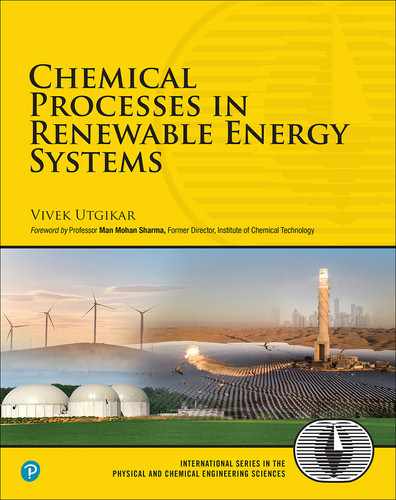Contents
Chapter 1 Introduction to Energy Systems
1.2 Energy System Architecture
1.3 Evolution of Energy Systems
1.3.1 Fossil Sources: Resource Limitations and Climate Change
1.3.2 Nuclear Energy: Economics, Safety, and Waste Management
1.4 Future Energy Systems: Growth of Renewables
Chapter 2 Renewable Energy Sources
2.1 Primary Renewable Energy Sources
2.2 Transformations of Primary Renewable Energy Sources
2.2.1 Transformations of Mechanical Energy Sources
2.2.2 Transformations of Geothermal Energy
2.2.3 Transformations of Solar Energy
2.2.4 Transformations of Biomass Energy
Chapter 3 Transformations and Chemical Processes in Solar Energy Systems
3.1 Solar Thermal (CSP) Systems
3.1.2 Chemistry and Processing of Solar Heat Exchange Media
3.2.1 PV Effect and Fundamental Structure of a PV Cell
3.2.2.1 Efficiency of PV Cells
3.2.2.2 Materials for PV Cells
3.2.3 Chemistry and Processing of PV Cell Materials
3.2.3.2 Amorphous Silicon and Gen 2 Thin Films
Chapter 4 Transformations and Chemical Processes in Biomass Energy Systems
4.1.1 Chemical Structure of Biomass
4.1.2 Physical Structure of Biomass
4.1.3 Implications of Biomass Composition and Structure on Processing for Bioenergy Applications
4.2.3 Physicochemical Pretreatment
4.2.5 Pretreatment of Algal Biomass
4.3.1 Thermochemical Processing of Biomass
4.3.2 Biochemical Processing of Biomass
4.3.2.1 Enzymatic Hydrolysis of Biomass
4.3.2.2 Fermentation of Sugars
4.3.3 Biomass Lipid Extraction and Conversion to Biodiesel
4.3.4 Generation 4 of Biomass Energy Systems—Emerging Technologies
Chapter 5 Transformations and Chemical Processes in Mechanical, Geothermal, and Ocean Energy Systems
5.1 Transformations of Mechanical Energy
5.1.1 Hydropower—Transformation of Potential Energy
5.1.2 Wind Power—Transformation of Kinetic Energy
5.2 Transformations of Geothermal Energy
5.2.1 Classification and Characteristics of Geothermal Resources
5.2.2 Energy Conversion Technologies
5.3 Transformations of Ocean Energy
5.3.1 Potential Energy Transformations
5.3.2 Kinetic Energy Transformations
5.3.3 Thermal Energy Transformations
5.3.4 Chemical Energy Transformations
5.3.4.1 Pressure-Retarded Osmosis
5.3.4.2 Reverse Electrodialysis
5.3.4.4 Capacitive Reverse Electrodialysis
Chapter 6 Hybrid Energy Systems
6.1 Intermittency in Renewable Energy Systems: Causes and Impacts
6.2 HES: Definition and Architecture
6.3 Energy Storage: Fundamentals and Alternatives
6.3.2.1 Storage by Conversion into Mechanical Energy
6.3.2.2 Storage by Conversion into Chemical Energy
6.3.2.3 Storage by Conversion into Thermal Energy
6.3.3 Characteristics and Applications of Energy Storage Systems
6.4 Separations and Processes in Chemical Energy Storage
6.4.1 Electrochemical Energy Storage
6.4.1.4 Sodium–Sulfur (Na–S) Battery
6.4.1.5 Vanadium Redox Battery
6.4.1.6 Comparison of Electrochemical Storage Alternatives
6.4.2.5 Merits and Demerits of Chemical Energy Storage Alternatives
6.4.2.6 Fuel Cells: Conversion of Chemical Energy to Electrical Energy
6.5 Separations and Processes in TES
6.5.1 Sensible Heat Storage Systems
6.5.2 Latent Heat Storage Systems
6.5.4 Comparison of TES Systems and Applications in RESs
Chapter 7 Techno-Economic Analysis of Renewable Energy Systems
7.1 Current Status of Renewable Energy Systems
7.2 Economics and Energy Balance of Energy Systems
7.2.1 Levelized Cost of Electricity
7.2.2 Overnight Cost of Power Plant
7.2.3 Energy Return on Energy Investment
7.3 Environmental Impacts of Renewable Energy Systems
7.4 Role of Public Policy in Energy Transitions
7.4.6 Strategies for Expansion of Renewable Energy
7.4.6.2 Renewable Portfolio Standards
Appendix A Conversion Factors and Constants
